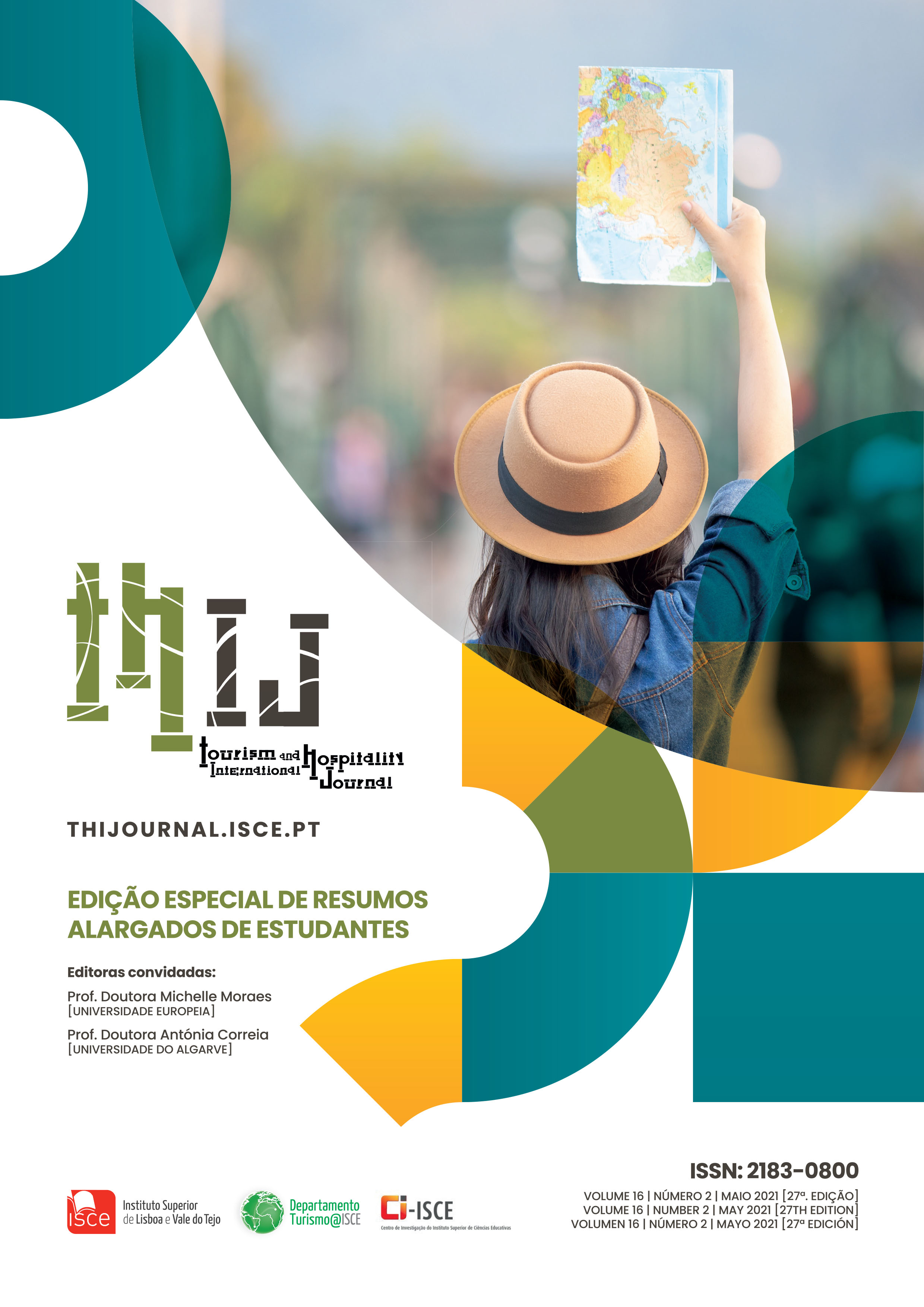Planeamento do turismo em Sundarbans através de um sistema de informação geográfica
DOI:
https://doi.org/10.57883/thij16(2)2021.30904Keywords:
Sundarbans, Tourism product, Tourism planning, Geographic information system, GeoportaAbstract
Sundarbans is the most extravagant natural tourism destination located in Eastern India. The beautiful mangrove forest offers a vibrant flora and fauna to the visitors. A large number of tourists visit Sundarbans every year not only for its flora and fauna but also for the excellent blend of cultural and historical resources. Nevertheless, the tourism industry has not developed correctly due to the lack of proper tourism product classification and scientific planning. Geographic Information System can be one of the most useful tools for tourism development in Sundarbans. This chapter presents the process of tourism circuit development in the Sundarbans. The chapter also highlights the scope and possibility of scientific tourism planning by using the Geographic Information System. An interactive map of Sunderbans is prepared by using ArcGIS 10.0 software to showcase the conceptual architecture of tourist information management by using a GIS-based interactive portal.
References
Avdimiotis, S., & Christou, E. (2004). GIS applications in tourism planning: A tool for sustainable development involving local communities. Journal of Environmental Protection & Ecology, 5(2), 457- 468. Retrieved February 05, 2021, from http://195.251.240.227/jspui/handle/123456789/4609
Bahaire, T., & Elliott-White, M. (1999). The application of geographical information systems (GIS) in sustainable tourism planning: A review. Journal of Sustainable Tourism, 7(2), 159-174. doi:10.1080/09669589908667333
Banerjee, A. (1998). Environment, population, and human settlements of Sundarban Delta. Concept Publishing Company. Retrieved from https://books.google.co.in/books?hl=en&lr=&id=zf_xv9LRd4cC&oi=fnd&pg=PA7&dq=Banerjee,+A.,+1998.+Environment,+population,+and+humansettlements+of+Sundarban+Delta.+Concept+Publishing+Company.&ots=GGFJdangA2&sig=3UDLUUMtYOKcfkW_UoUovJ47lNQ&redir_esc=y#v=onep
Biswas, S., Rakshit, D., Sarkar, S. K., Sarangi, R. K., & Satpathy, K. (2014). Impact of multispecies diatom bloom on plankton community structure in Sundarban mangrove wetland, India. Marine pollution bulletin, 85(1), 306 -311. doi:10.1016/j.marpolbul.2014.04.015
Boers, B., & Cottrell, S. (2007). Sustainable tourism infrastructure planning: A GIS-supported approach. Tourism Geographies, 9(1), 1 -21. doi:10.1080/14616680601092824
Bonham, C., & Graeme, F. (2014). Geographic information systems for geoscientists: modelling with GIS (Vol. 13). USA: Elsevier. Retrieved February 2, 2021, from https://books.google.co.in/books?hl=en&lr=&id=FkKeBQAAQBAJ&oi=fnd&pg=PP1&dq=Bonham-Carter,+GF,+2014.+Geographic+informationsystems+for+geoscientists:+modelling+with+GIS+(Vol.+13).+Elsevier&ots=NexIo51-Fu&sig=vfqntfJGmsQFdN7uZpaogwbUY-M&redir_esc=y#v=onepa
Chandel, R. S., & Kanga, S. (2018). Use of Geo-Spatial Techniques to Manage the Tourists & Administration: A Case Study of Mount Abu, Rajasthan. Society for Environment and Development,(India. Retrieved January 27, 2021, from http://www.sedindia.org
Delorme, D., Gray, K., Autry, G., & Moulton, K. (2001, November 20). Integrated routing/mapping information. US Patent 6,321,158. Google Patents. Retrieved February 1, 2021, from https://patents.google.com/patent/US6321158B1/en
Fung, T., & Wong, F. K. (2007). Ecotourism planning using multiple criteria evaluation with GIS. Geocarto International, 22(2), 87-105. doi:10.1080/10106040701207332
Garc, a.-P., Juan, C., Gutierrez, J., & Mnguez, C. (2015). Identification of tourist hot spots based on social networks: A comparative analysis of European metropolises using photo-sharing services and GIS. Applied Geography, 63, 408--417. doi:0143622815001952
Goodbred, J., Steven, L., Paolo, P., Ullah, M., Pate, R., Khan, S., . . . Rahaman, W. (2014). Piecing togetherthe Ganges-Brahmaputra-Meghna River delta: Use of sediment provenance toreconstruct the history and interaction of multiple fluvial systems duringHolocene delta evolution. Geological Society of America Bulletin, 126(11-12), pp. 1495--1510. doi:10.1130/B30965.1
Hallo, J., Beeco, J., Goetcheus, C., McGee, J., McGehee, N., & Norman, W. (2012). GPS as a method for assessing spatial and temporal use distributions of nature-based tourists. Journal of Travel Research, 51(5), 591-606. doi:10.1177/0047287511431325
Ishtiaque, A., S.W, M., & Wang, C. (2016). Examining theecosystem health and sustainability of the world's largest mangrove forestusing multi-temporal MODIS products. Science ofthe Total Environment, 569, 1241--1254. doi:https://doi.org/10.1016/j.scitotenv.2016.06.200
Lange, E., & Bishop, I. (2005). Visualization in landscape and environmental planning: technology and applications. Taylor & Francis. Retrieved January 27, 2021, from https://books.google.co.in/books?hl=en&lr=&id=4_PYxp31zGwC&oi=fnd&pg=PR9&dq=Lange,+E.+and+Bishop,+I.D.,+eds.,+2005.+Visualisationin+landscape+and+environmental+planning:+technology+and+applications.+Taylor%26+Francis.&ots=lXJ_dcak_s&sig=FO5ZSHW3gD0Q7zlm_1
Li, X., & Yeh, A.-O. (2004). Analyzing spatial restructuring of land use patterns in a fast growing region using remote sensing and GIS. Landscape and Urban planning, 69(04), 335-354. doi:0169204603002500
Liu, D., Iverson, L., & Brown, S. (1993). Rates and patterns of deforestation in the Philippines: application of geographic information system analysis. Forest Ecology and Management, 57(1-4), 1-16. doi:10.1016/0378-1127(93)90158-J
Manna, S., Chaudhuri, K., Bhattacharyya, S., & Bhattacharyya, M. (2010). Dynamics of Sundarban estuarine ecosystem: eutrophication induced threat to mangroves. Saline systems, 6(1), 1-16. doi:10.1186/1746-1448-6-8
Montgomery, S. (2009). Spell of the tiger: the man-eaters of Sundarbans. Chelsea Green Publishing. Retrieved January 31, 2021, from https://books.google.co.in/books?hl=en&lr=&id=zU7PmIjthpoC&oi=fnd&pg=PR9&dq=Montgomery,+S.,+2009.+Spell+of+the+tiger:+theman-eaters+of+Sundarbans.+Chelsea+Green+Publishing&ots=K7JBktlUKX&sig=UYyRKqbX-oBbaZKJV_aXdo0ZWmk&redir_esc=y#v=onepage&q=Montgomery%2
Naha, D., Jhala, Y., Qureshi, Q., Roy, M., Sankar, K., & Gopal, R. (2016). Ranging, activity and habitat use by tigers in the mangrove forests of the Sundarban. PLoS One, 11(4), e0152119. doi:10.1371/journal.pone.0152119
Raha Atanu Kumar, et al. (2015). Impact of Sea Level Rise on Mangrove Vegetation of Sundarban Tiger Reserve. Journal of Ecology and Environmental Sciences, 6(2), 154 - 162. doi:10.9735/0976-9900
Sahana, M., & Sajjad, H. (2019). Vulnerability to storm surge flood using remote sensing and GIS techniques: A study on Sundarban Biosphere Reserve, India. Remote Sensing Applications: Society and Environment, 13, 106-120. doi:10.1016/j.rsase.2018.10.008
Sen, N. S. (2003). axonomy and ecology of the algal flora of Sundarbans Mangals in West Bengal India with special reference to estimation of their contribution to the primary productivity of the estuarine ecosystems. Kolkata: Sodhganga. Retrieved January 23, 2021, from https://shodhganga.inflibnet.ac.in/handle/10603/155976
Downloads
Published
How to Cite
Issue
Section
License
Copyright (c) 2023 This work is licensed under a Creative Commons - Attribution 4.0 International (CC BY 4.0

This work is licensed under a Creative Commons Attribution 4.0 International License.
This work is published under the Creative Commons Attribution 4.0 International License.






